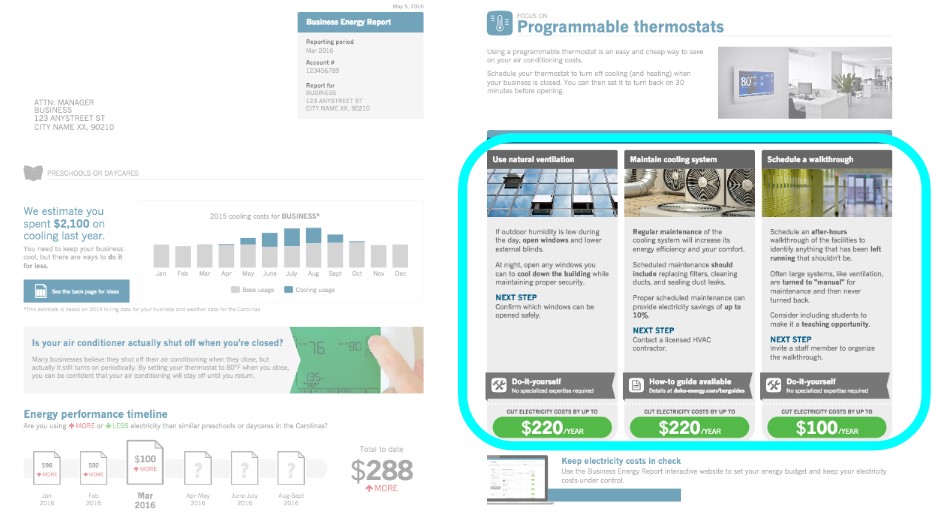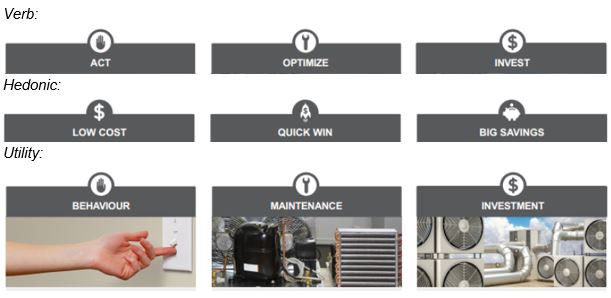By Yardi Blog Staff on December 30, 2016 in Technology
Editor’s note: The following piece and accompanying graphics are re-published with permission from Home Energy Magazine.
Behavioral recommendations, or tips, are an integral piece of many energy efficiency programs, ranging from marketing materials (e.g., brochures) to in-home audits, to Home and Business Energy Reports (such as the report shown below). Though information is known to be a critical component of effective interventions, it is important to consider human motivations and needs for this to be effective. This article synthesizes findings from a series of empirical research conducted by See Change Institute and Yardi (formerly Pulse) Energy’s Business Energy Report (BER) program[1]. By breaking apart the tips from the energy report (sample below) and breaking down the components of those tips even further, we were able to test the impact of variations of different components of tips, with the goal of optimizing messaging to incite pro-efficiency behavior in BER recipients[2].
In synthesizing these findings, we identified five key insights on tip content, form, structure, and imaging, or “Tips for Tips”.

1. Put People in Pictures
First, we tested the impact of having people in images above the tips – one tip had a picture of equipment, the other included someone actually engaging in the behavior being promoted. We found that tips with an image of a person engaging in the action were rated significantly higher in terms of behavioral intention (that is, how much someone self-reports intention to complete the recommended action).We recommend considering images that do include people, especially people engaging in the recommended action.

2. Tell People What to Do
Next, we tested the difference between a “subject title” (e.g., “Ceiling Fans”) and an “action title” (e.g.,”Use fans more & A/C less”). We found that using an action title led people to both say they found the tip more engaging and to report that they plan to take the suggested action. When labeling a tip, don’t be afraid to tell them what to do – an actionable directive is more appreciated than a vague subject.

3. Be Specific with Savings
We also looked at the difference between two rebate banners. Banners are highlighted text included in the content of a tip when a utility rebate is available. In this experiment, one banner had a specified dollar amount of savings, and another had more vague language stating that there were rebates available. We found that the banner with the specified $1.50 per tube amount lead people to say they found the information more easily understandable, trustworthy, and useful. People like specificity in knowing exactly how much they can potentially save, so present that information upfront when possible.

4. Be Clear and Relatable
In our next experiment, we tested three different ways to label tips by category; we called these “verb”, “hedonic” (or more cute and relatable language), and “utility” (how a utility would typically categorize these tips). Note that this is different than tip titles (discussed in Tip #2), since titles can still be used below these labels. We found that when people were exposed to the “hedonic” titles, they were more likely to say they would complete the recommended actions, and also reported that the information was more engaging and interesting. Energy use might be serious business, but people might shy away from jargon, so whenever possible be sure to use familiar language.

5. Show Savings, not Costs
Finally, we tested different ways to frame savings. We tested the difference between framing savings using the language “Save up to” vs. “Cut energy costs by up to.” We found that when respondents saw “save up to”, they were more likely to report that they would complete the recommended action, and also found the information more user-friendly, as compared to “cut energy costs by up to.” These findings suggest that it could actually be more impactful, when discussing savings, to focus on the savings in terms of gains (i.e., what someone will actually save) rather than losses (i.e., avoiding or cutting costs). Interestingly, these findings contradict some foundational theories in behavioral science on the power of loss framing. Our findings re-emphasize the importance of pre-testing the assumptions of behavioral science in the context of energy efficiency messaging.

While there are numerous decisions to make when you prepare materials with energy behavior tips, and certainly more potential for variation and experimentation than we described here, we hope that this list helps you when you’re crafting tips. We’re continuing to hypothesize and test ways to engage people in energy efficiency and welcome any comments or suggestions. By better understanding the way people respond to variations in tips, we can better hone in on qualities that help tips more strongly encourage pro-efficiency behavior change.
Contributors to this article include Jason Kaufman and Beth Karlin, See Change Institute; Angela Sanguinetti, UC Davis; and Laura Cornish, Pulse Energy.
Learn more
Kaufman, J., Karlin, B., Sanguinetti, A., & Cornish, L. (2016). Tips for Tips: Effective Strategies for Presenting Behavioral Recommendations. Home Energy Magazine. Retrieved from: http://homeenergy.org/show/blog/id/917/nav/blog.
[1] Pulse Energy was recently acquired by Yardi Systems
[2] For additional information on study methodology, please contact the authors or visit www.seechangeinstitute.com/tips-for-tips.


